
AND PHOTOELECTRIC BEAMS
USED BY THE ROYAL AUSTRALIAN NAVY AT MYRTLETOWN, BRISBANE

This is the story of the indicator loop and photoelectric beam station built during WW2 as part of the Royal Australian Navy's anti-submarine harbour defences of Moreton Bay. It was located at Myrtletown, at the mouth of the Brisbane River, Australia. It was called RAN 9.
 |
If you have any feedback please email me: Dr Richard Walding Research Fellow - School of Science Griffith University Brisbane, Australia Email: waldingr49@yahoo.com.au |
LINKS TO SOME OF MY RELATED PAGES:
Go to the end for a location map. This page was updated on 20 June 2008.
Click here for more details of:Overview of Naval anti-submarine fixed defences in Moreton Bay;
Indicator Loops around the World (Home Page) How an indicator loop works Oban Bay (Scotland) indicator loop station United States Navy Indicator Loop Receiving Stations Fort Bribie and RAN No. 2 Mine Indicator Loop Station
Myrtletown is a suburb on the north side of the Brisbane
River, just at its mouth. Today it has the Brisbane Airport
to the West, Luggage Point Sewage Treatment Plant to the
North, the BP Oil refinery to the South, and Fisherman
Island Port to the West. There are several house there in
this generally industrial area. The RAN9 huts are located in
a very pleasant Brisbane City Council park which is very
well maintained.


On 2nd September 1942, the Naval Officer in Charge (NOIC, Brisbane) advised that an indicator loop and PE beam was needed for the Brisbane River. By October 3, staffing had been decided as 2 Lt or SubLt and 4 submarine detectors and one steward. In January 1943, a budget allocation of £3450 had been approved. On January 20, Cmr Harvey Newcombe, Commanding Officer "Rushcutter" wrote "proceed with at once". The Indicator Loop cables were laid in miniature indicator loop pattern with legs 40 yds apart. This was to detect miniature submarines and human torpedos.
The total cost was:
| Item |
Cost (£) |
| Indicator Loop & PE Control Building | 1060 |
| PE Beam - Transmitter Building (Bulwer) | 292 |
| Powerhouse/store | 540 |
| Septic tank | 105 |
| Accommodation for 4 officers and 10 ratings | 1050 |
| 200 ft EWP drains | 40 |
| 15 chains of fencing | 120 |
| Light/power | 295 |
| Sundries (BCC) | - |
| 3337 |
The Brisbane City Council supply taken from the other side of the river was intended to run two motor generators. However, the BCC supply was unreliable but there was little they could do about it. The PE beam was completed on 22 September 1943 and on 23 October 1943 the first trial of the beam was undertaken and all went well. Lt Joe Duggan was the Officer in Charge. He had most of 1943 at the IL station (RAN4) at Woorim, Bribie Island.
Unfortunately, the poor power supply meant that a decent petrol electric generator was needed. The Norman Petrol Electric Generator (½kW @ 110V) was selected but they wouldn't be available until 1 July 1944. By 10 July 1944 the first generator was despatched. On 2 July 1945 all PE, IL equipment was removed. The 4 buildings (IL hut, PE hut, power house, accommodation) were disposed of. The accountants said that the actual costs of the station came to £4988 and requested a further £1101 to cover costs.
DEVELOPMENT OF P.E. BEAM INSTALLATIONS
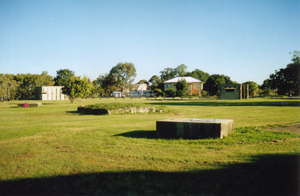 |
 |
| In the background the Control Hut and the Generator Hut can be seen. The house in the centre is on the other side of Gannon Road. In the foreground is the concrete pad for the toilet block, and behind that, the footings for the accommodation hut. | The view - facing downstream - from the Control Hut across the Brisbane River to Fishermans Island. The location of the PE Transmitter is over the river just obscured by the tree. |
By 1942, the navy had become aware of recent developments by Japan, Germany and Italy in the manufacture and use of miniature submarines and human torpedoes. Existing indicator loop systems had legs at a 200 yard spacing which was fine for large submarines but useless for the miniatures. On advice from the Royal Navy two miniature indicator loops were added as inner defences at Sydney Harbour in January 1942 and these were successful in detecting the passage of the Japanese midget submarines into the harbour on 31st May 1942.
By September that year the RAN decided to lay a miniature
indicator loop across the mouth of the Brisbane River. It
was also decided to supplement this with a PE beam over
the top of the loop system. Lt Col L G Buckland from the
army was approached to carry out this task. Lt Col
L G Buckland was responsible for the PE Beam installed at
Sydney Heads (August 1942) and subsequently at Port
Phillip in Melbourne (September 1942). The Sydney beam
ran between Hornby and Middle Head; the Port Phillip PE
Beam ran between Point Lonsdale and Nepean - a distance
of about 4000 yards. Because of difficulties with the
tides and sea spray at Port Phillip, they decided to
install two beams; one for low tide, and one for high
tide. The equipment worked best when the beam was about 7
foot above the water's surface. During an earlier trial
at Port Phillip (650 hours), the beam detected 225 boats
and missed 3 (very small fishing boats). There was
another 265 "false positives" due to rain, birds and
waves.
The Sydney and Brisbane PE Beams were requested by the
RAN. The Port Phillip beam was an army project. By March
1944, the army decided to discontinue the Port Phillip
beam.
HOW THE P.E. BEAM WORKED
The P.E. Beam equipment consisted of a transmitter on the
Fisherman Island side of the river housed in a concrete bunker.
It was basically a power valve that transmitted in the
visible and infrared wavelengths. An "infrared screen"
blocked out the visible light so that it couldn't be seen
from the outside. The beam from the transmitter was
directed at the reflector (a 90 cm parabolic mirror)
which focussed the rays to a pin point on the cathode of
the PE Cell.
Breaking the beam closes a contactor on to an 80 V DC supply and connects it in parallel with a service contactor. While the beam is in normal operation, a loudspeaker gives a buzzing note. When the beam is broken, the speaker reproduces the clicking of the receiver relay. An alarm buzzer is also sounded and a flashing red light comes on actuated by the relay.
During this interruption, another contactor closes and a sentry (searchlight) is exposed across the river, on a bearing a few degrees inside the line of the infrared PE beam. The service contactor switch for the searchlight is then closed by the switchman, who carries out a quick search of the area; the control panel contactor being immediately reset by pressing a button on the control panel. Resetting stops the alarm buzzer, flashing light and the clicking in the loudspeaker, leaving the apparatus ready to give another signature immediately.
LAYOUT AT MYRTLETOWN
The PE Beam and Loop
Hut - was arranged as follows. The hut was made of concrete
12" thick and was approximately 19' x 22'.

 |
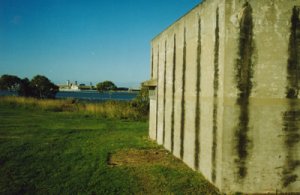 |
| Control hut showing PE Beam opening and observation window facing River. | Control hut looking downstream. The Indicator Loop observation window is at the front. |
The Generator Hut - was about 18' x 18'6":

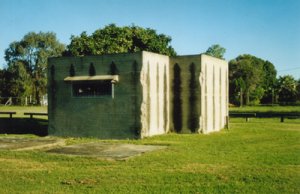 |
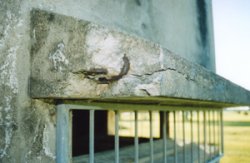 |
| The Generator Hut (with Gannon Road behind). There was a window on the front and a bigger one on the side. The stains are from water dripping out of the seep holes on the roof (concrete sealed with bitumen). | The window hood on the Generator Room. Years of salt-laden moist air has caused the spalling of the concrete. The reinforcing rods are now plain to see. The galvanised grill below the hood was added recently by the Brisbane City Council. |
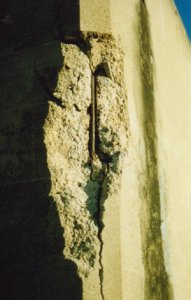 |
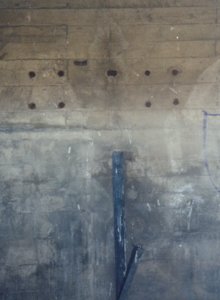 |
| Spalling of the concrete corner of the Generator Hut. Very little can be done now to preserve the hut from further deterioation. | Rear wall of the Generator Hut. The wooden dowel was set into the concrete for mounting voltmeters and ammeters. |
 |
 |
| The power cable exiting the Generator Hut - on its way to the Control Hut and accommodation huts | A close-up of the armoured cable. The steel armour wires are bent back over a "pudding ring" (like a napkin ring) and then bound with wire. |